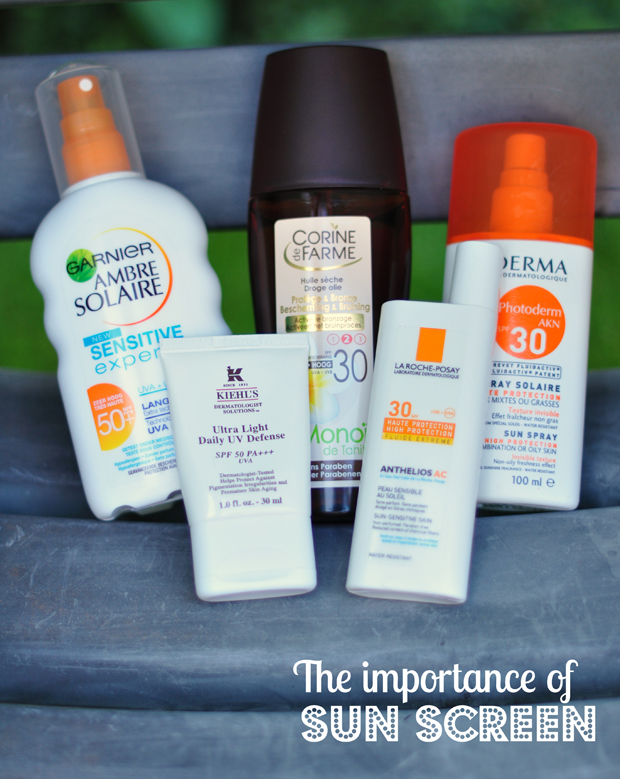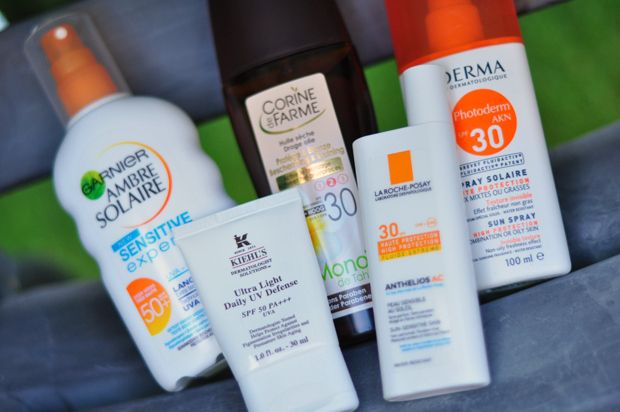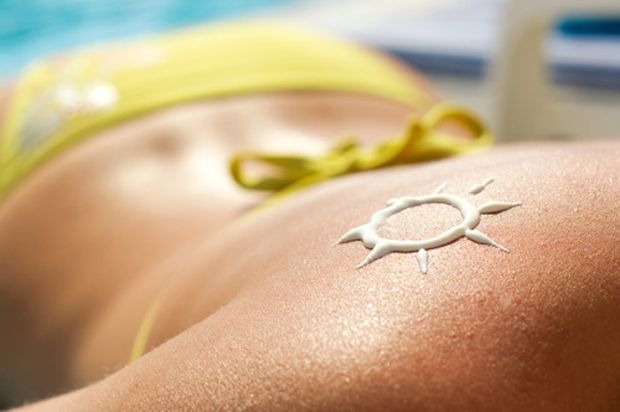If there’s one thing I’d say to my younger self it’s the request to take better care of myself, and my skin in particular. If you haven’t seen the “Dear 16 year old me” video, now’s the time (I’ve enclosed it below). People often forget that the skin is the largest organ and you really need to take care of it.
Now that I’ve grown older and wiser I’m taking much better care of my skin and I refuse to leave the house without some spf. I might’ve learned my lesson but it seems a lot of my peers have not. After looking at me like I’m some narcissistic weirdo when I’m re-applying my sunscreen there’s a common response to my question if they want to use it too: “It’s okay, I don’t burn that easily”. It seems there are a lot of misconceptions about using sunscreen so I thought it was about time to set some facts straight!
Rule of thumb: there is no such thing as healthy tanning! Too much sun can become dangerous to the skin and body. Sunburn is just one of the side effects from an overexposure to harmful ultraviolet (UV) rays. Other serious health problems can arise from sun exposure, including premature aging of the skin, eye damage such as cataracts, suppression of the immune system, and even skin cancer!! Skin cancer is one of the most common types of cancer and also one of the most preventable.
Sunburn is associated with the shorter ultraviolet wavelengths (= ultraviolet B (UVB)) and the longer wavelengths are known as ultraviolet A (UVA). The latter ones can penetrate the skin and damage the connective tissue at deeper levels, even if the skin’s surface feels cool. It is important to limit exposure to both UVA and UVB.
One way to protect yourself is to use sunscreen. There are a lot of sunscreens on the market so finding the right one for you might be a challenge. My current favorite for the face is Kiehl’s Ultra Light Daily UV Defense (SPF 50). It works like a charm and is perfect for those with combination/oily skin. I’m still looking for a perfect match for my body. I tried the new Garnier Ambre Solaire Sensitive Expert (SPF 50) this year on vacation and it didn’t work out. It wasn’t easy to apply and it sort of all gunked up and fell off in tiny little flakes after only 1 hour or so. I’m not a fan.
Are you looking for a new sunscreen as well? Here are some things you should know:
Sunscreen or Sunblock?
Sunscreen refers to products that allow the sun’s rays to penetrate the skin but filter some of the radiation in the ultra violet spectrum. The UV rays get altered to a safer wavelength and are released. The chemical interaction between the sunscreen and UV allows the sunscreen to absorb the UV before it penetrates the skin. Sunscreen offers protection from UV-A and UV-B, however some sunscreen products offer no protection against UV-A radiation.
Sunblock works by preventing the sun rays from reaching your skin – either by reflecting them away or absorbing them, changing their structure and releasing them. Sunblock used to sit on top of your skin and had a white appearance. With nano technology (making things really small) some sun blocking ingredients are now invisible to the eye. The main active ingredients in sunblock are titanium dioxide and zinc oxide.
UV Protection
SPF
Sunscreens are labeled with SPF numbers (“Sun Protection Factor”). The higher the SPF number, the more sunburn protection the product provides. The effectiveness is reduced if it is not applied in adequate amounts or it is washed off, rubbed off, sweated off, or otherwise removed. For maximum effectiveness, apply a sunscreen liberally and reapply it frequently. Sunburn is caused by UV-B radiation, so the SPF doesn’t indicate how well you’ll be protected from UV-A radiation (responsible for skin ageing and skin cancer) and thus creating a false sense of security.
Broad Spectrum
Sunscreens that prevent at least some of both UVA and UVB rays from damaging your skin are called ‘broad spectrum‘. When choosing which product to buy look for one which states either ‘broad spectrum’, ‘multi spectrum’ or that it blocks both UVA/UVB. Even though a product may display the term ‘broad spectrum’ it may not block all UVA and UVB radiation so check the ingredients to find out more.
Sunscreen Ingredients
Physical or Mineral Sunscreens
A physical sunscreen, or sunblock, contains natural minerals and sits on your skin’s surface forming a protective barrier (so it doesn’t get absorbed into your skin). Light is either absorbed into the ingredient or reflected away from your body back into the atmosphere. Physical sunscreens are immediately effective.
Titanium dioxide offers protection from UVB and short UVA radiation, but not long wave UVA. Titanium dioxide is also non-irritating.
Zinc oxide offers broad-spectrum protection (UVB and most of UVA). Arguably the best broad-spectrum protection available.
Chemical Sunscreens
Chemical sunscreens absorb the sunlight to prevent sun damage and they also get absorbed into your skin. Unlike physical sunscreens they are not immediately effective and require a 20-30 minute delay after application before they become effective. Some people experience allergic reactions and burning eyes when perspiring.
Click through for a list of chemical ingredients and the amount of protection they offer (page 4).
Nano
Some of the newest sunscreen products use nanotechnology to make formulas that are more aesthetically pleasing. Nanotechnology has made it possible to produce completely clear sunscreens which still fend off UV rays just as effectively. They contain the same ingredients as traditional formulations, but the inorganic particles are so small that they are invisible.
Is Your Sunscreen Toxic?
Even though I initially started to blog about this to promote the use of sunscreen, there’s also another side to the coin that I have to mention. Not all of the ingredients are safe. Here are 6 sunscreen ingredients you better avoid:
Oxybenzone
This penetration enhancer undergoes a chemical reaction when exposed to UV rays. It can cause an eczema-like allergic reaction that can spread beyond the exposed area and last long after you’re out of the sun. It’s also suspected to disrupt hormones (i.e., mimics, blocks, and alters hormone levels) which can throw off your endocrine system.
Octinoxate
One of the most common ingredients found in sunscreens with SPF. This can cause harmful effects on estrogen. Though SPF products are designed to protect skin from sun-induced aging, octinoxate may actually be a culprit for premature aging, as it produces menacing free radicals that can damage skin and cells.
Retinyl Palmitate (Vitamin A Palmitate)
When exposed to the sun’s UV rays, retinol compounds break down and produce destructive free radicals that are toxic to cells, damage DNA, and may speed the development of skin tumors and lesions.
Homosalate
Homosalate accumulates in our bodies faster than we can get rid of it, becomes toxic and disrupts our hormones.
Octocrylene
When this chemical is exposed to UV light, it absorbs the rays and produces oxygen radicals that can damage cells and cause mutations. It is readily absorbed by your skin and may accumulate within your body in measurable amounts. Plus, it can be toxic to the environment.
Paraben Preservatives
Associated with both acute and chronic side effects, parabens (butyl-, ethyl-, methyl-, and propyl-) can induce allergic reactions, hormone disruption, developmental and reproductive toxicity.
One last word of advice:
– use a product with a SPF of at least 15 and a maximum of 50
– choose a lotion over a spray (inhaling particles may be toxic for your lungs)
– go for a product that protects you from both UVA/UVB rays
– avoid the malicious ingredients mentioned above
– apply at least a shot glass of product and apply every 2 hours (or after toweling off, swimming or heavy sweating)
– get your skin checked by a dermatologist at least once a year
But remember: wearing sunscreen is not enough! Check this website for other tips on how to enjoy the sun and stay as safe as possible.
Products: Kiehl’s Ultra Light Daily UV Defense (SPF 50, UVA), Garnier Ambre Solaire Sensitive Skin Expert (SPF50, Corine de Farme Monoï de Tahiti Dry Oil (SPF 30), La Roche Posay Anthelios for sensitive skin (SPF 30), Bioderma Photoderm Sun Spray for combination & oily skin (SPF 30).







GREAT post! I constantly try to tell people this, but they often just laugh at me and tell me I am exaggerating. No mom, no dad, no boyfriend, I am NOT! And this proves it 🙂
goed artikel met veel info! nog een ding dat mensen vaak niet weten: zon is belangrijk voor vitamine D. Mensen die teveel sunblock dragen kunnen daar effectief ziek van worden omdat ze een gebrek aan vitamine D ontwikkelen. Dat is wel individueel bepaald en hangt samen met hoe licht je huid is (hoe donkerder: hoe meer zon je nodig hebt voor vitamine d productie).
Author
Ja was aan het twijfelen of het toch niet te lang was voor een blogpost maar het is zo belangrijk om te weten. Ik wist niet dat er mensen zijn die teveel sunblock dragen 😀 Teveel van iets is nooit goed hé
Zo jammer dat veel mensen geen of te weinig zonnecrème gebruiken omdat ze gewoon niet goed geïnformeerd zijn, ik merk het ook in mijn vriendenkring. Super dat je hier zo uitgebreid aandacht aan besteedt, zelfs als actief zonnecrèmegebruikster heb ik hier nog wat van bijgeleerd!